+ Open data
Open data
- Basic information
Basic information
| Entry | Database: PDB / ID: 2wuy | ||||||
|---|---|---|---|---|---|---|---|
| Title | the crystal structure of wild-type baculovirus polyhedra | ||||||
 Components Components | POLYHEDRIN | ||||||
 Keywords Keywords | VIRAL PROTEIN / MICROCRYSTALS / POLYHEDRA / VIRUS / VIRAL OCCLUSION BODY / VIRAL CAPSID | ||||||
| Function / homology | Polyhedrin / Polyhedrin / viral occlusion body / host cell nuclear matrix / structural molecule activity / identical protein binding / Polyhedrin Function and homology information Function and homology information | ||||||
| Biological species |  AUTOGRAPHA CALIFORNICA NUCLEAR POLYHEDROSIS VIRUS AUTOGRAPHA CALIFORNICA NUCLEAR POLYHEDROSIS VIRUS | ||||||
| Method |  X-RAY DIFFRACTION / X-RAY DIFFRACTION /  SYNCHROTRON / SYNCHROTRON /  MOLECULAR REPLACEMENT / Resolution: 3.09 Å MOLECULAR REPLACEMENT / Resolution: 3.09 Å | ||||||
 Authors Authors | Ji, X. / Sutton, G. / Evans, G. / Axford, D. / Owen, R. / Stuart, D.I. | ||||||
 Citation Citation |  Journal: Embo J. / Year: 2010 Journal: Embo J. / Year: 2010Title: How Baculovirus Polyhedra Fit Square Pegs Into Round Holes to Robustly Package Viruses. Authors: Ji, X. / Sutton, G. / Evans, G. / Axford, D. / Owen, R. / Stuart, D.I. | ||||||
| History |
|
- Structure visualization
Structure visualization
| Structure viewer | Molecule:  Molmil Molmil Jmol/JSmol Jmol/JSmol |
|---|
- Downloads & links
Downloads & links
- Download
Download
| PDBx/mmCIF format |  2wuy.cif.gz 2wuy.cif.gz | 55 KB | Display |  PDBx/mmCIF format PDBx/mmCIF format |
|---|---|---|---|---|
| PDB format |  pdb2wuy.ent.gz pdb2wuy.ent.gz | 40.1 KB | Display |  PDB format PDB format |
| PDBx/mmJSON format |  2wuy.json.gz 2wuy.json.gz | Tree view |  PDBx/mmJSON format PDBx/mmJSON format | |
| Others |  Other downloads Other downloads |
-Validation report
| Summary document |  2wuy_validation.pdf.gz 2wuy_validation.pdf.gz | 423.5 KB | Display |  wwPDB validaton report wwPDB validaton report |
|---|---|---|---|---|
| Full document |  2wuy_full_validation.pdf.gz 2wuy_full_validation.pdf.gz | 425.8 KB | Display | |
| Data in XML |  2wuy_validation.xml.gz 2wuy_validation.xml.gz | 9.2 KB | Display | |
| Data in CIF |  2wuy_validation.cif.gz 2wuy_validation.cif.gz | 11.3 KB | Display | |
| Arichive directory |  https://data.pdbj.org/pub/pdb/validation_reports/wu/2wuy https://data.pdbj.org/pub/pdb/validation_reports/wu/2wuy ftp://data.pdbj.org/pub/pdb/validation_reports/wu/2wuy ftp://data.pdbj.org/pub/pdb/validation_reports/wu/2wuy | HTTPS FTP |
-Related structure data
| Related structure data | 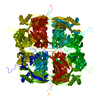 2wuxSC S: Starting model for refinement C: citing same article ( |
|---|---|
| Similar structure data |
- Links
Links
- Assembly
Assembly
| Deposited unit | 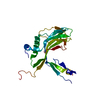
| ||||||||
|---|---|---|---|---|---|---|---|---|---|
| 1 | x 12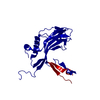
| ||||||||
| Unit cell |
|
- Components
Components
| #1: Protein | Mass: 28678.725 Da / Num. of mol.: 1 Source method: isolated from a genetically manipulated source Source: (gene. exp.)  AUTOGRAPHA CALIFORNICA NUCLEAR POLYHEDROSIS VIRUS AUTOGRAPHA CALIFORNICA NUCLEAR POLYHEDROSIS VIRUSCell line (production host): SF9 / Production host:  |
|---|
-Experimental details
-Experiment
| Experiment | Method:  X-RAY DIFFRACTION / Number of used crystals: 7 X-RAY DIFFRACTION / Number of used crystals: 7 |
|---|
- Sample preparation
Sample preparation
| Crystal | Density Matthews: 1.52 Å3/Da / Density % sol: 20 % / Description: NONE |
|---|---|
| Crystal grow | pH: 7.5 / Details: pH 7.5 |
-Data collection
| Diffraction | Mean temperature: 100 K |
|---|---|
| Diffraction source | Source:  SYNCHROTRON / Site: SYNCHROTRON / Site:  Diamond Diamond  / Beamline: I24 / Wavelength: 0.9778 / Beamline: I24 / Wavelength: 0.9778 |
| Detector | Type: MARRESEARCH / Detector: CCD / Date: Jul 13, 2009 / Details: MIRRORS |
| Radiation | Monochromator: DOUBLE CRYSTAL MONOCHROMATOR / Protocol: SINGLE WAVELENGTH / Monochromatic (M) / Laue (L): M / Scattering type: x-ray |
| Radiation wavelength | Wavelength: 0.9778 Å / Relative weight: 1 |
| Reflection | Resolution: 3→50 Å / Num. obs: 3329 / % possible obs: 99.6 % / Observed criterion σ(I): -1.5 / Redundancy: 6.8 % / Biso Wilson estimate: 51.05 Å2 / Rmerge(I) obs: 0.38 / Net I/σ(I): 4.4 |
| Reflection shell | Resolution: 3→3.11 Å / Redundancy: 6.4 % / Mean I/σ(I) obs: 1.4 / % possible all: 100 |
- Processing
Processing
| Software |
| ||||||||||||||||||||||||||||||||||||||||||||||||||||||||||||||||||||||||||||||||||||||||||||||||||||||||||||||||||
|---|---|---|---|---|---|---|---|---|---|---|---|---|---|---|---|---|---|---|---|---|---|---|---|---|---|---|---|---|---|---|---|---|---|---|---|---|---|---|---|---|---|---|---|---|---|---|---|---|---|---|---|---|---|---|---|---|---|---|---|---|---|---|---|---|---|---|---|---|---|---|---|---|---|---|---|---|---|---|---|---|---|---|---|---|---|---|---|---|---|---|---|---|---|---|---|---|---|---|---|---|---|---|---|---|---|---|---|---|---|---|---|---|---|---|---|
| Refinement | Method to determine structure:  MOLECULAR REPLACEMENT MOLECULAR REPLACEMENTStarting model: PDB ENTRY 2WUX Resolution: 3.09→41.46 Å / Cor.coef. Fo:Fc: 0.8823 / Cor.coef. Fo:Fc free: 0.829 / Cross valid method: THROUGHOUT / σ(F): 0
| ||||||||||||||||||||||||||||||||||||||||||||||||||||||||||||||||||||||||||||||||||||||||||||||||||||||||||||||||||
| Displacement parameters | Biso mean: 28.76 Å2 | ||||||||||||||||||||||||||||||||||||||||||||||||||||||||||||||||||||||||||||||||||||||||||||||||||||||||||||||||||
| Refinement step | Cycle: LAST / Resolution: 3.09→41.46 Å
| ||||||||||||||||||||||||||||||||||||||||||||||||||||||||||||||||||||||||||||||||||||||||||||||||||||||||||||||||||
| Refine LS restraints |
| ||||||||||||||||||||||||||||||||||||||||||||||||||||||||||||||||||||||||||||||||||||||||||||||||||||||||||||||||||
| LS refinement shell | Resolution: 3.09→3.45 Å / Total num. of bins used: 5
|
 Movie
Movie Controller
Controller



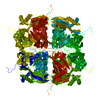

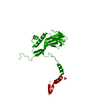
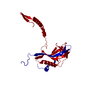
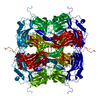
 PDBj
PDBj